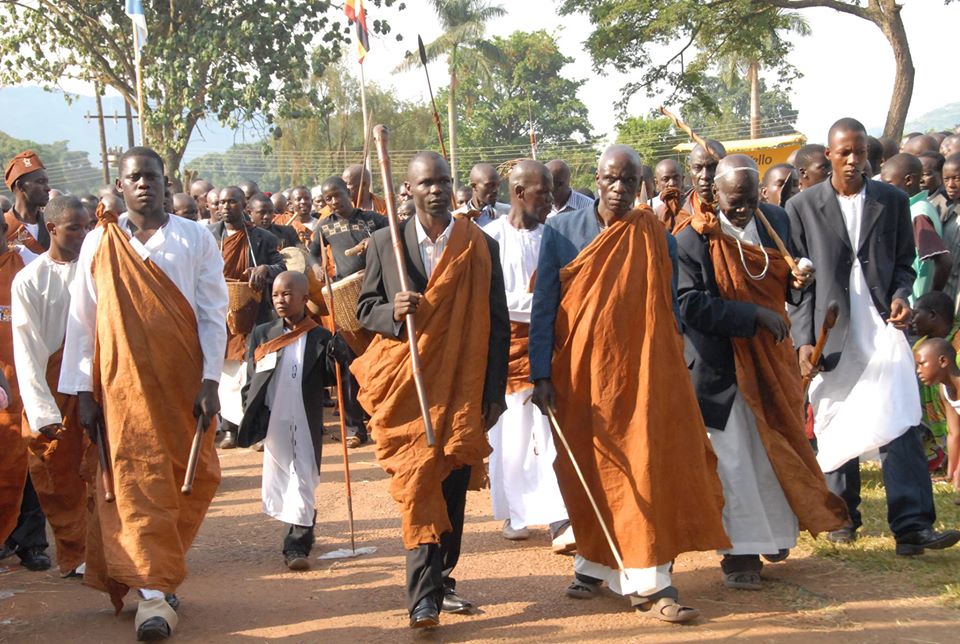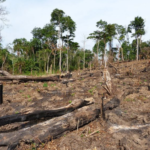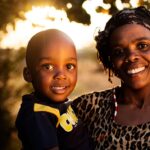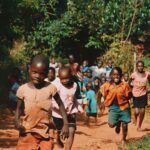
Bunyoro Kitara kingdom boasts of a rich culture and heritage that transcends generations from the ancient dynasties and interraclastrine civilisations.
Inspite of Western cultural imperialism, the Banyoro have maintained their rich cultural heritage. While many Western cultural elements have been assimilated, many Banyoro proudly uphold the ancient traditions of their ancestors. Under the leadership of H.M. Solomon Gafabusa Iguru I, great efforts are underway to revive many of their cultural traditons, and document them for posterity. Schools are encouraged to include traditional kinyoro (adjective) culture in the curriculum.
Empango Ceremony
This is an annual cerebration which marks the coronation anniversary of the Reigning Omukama. This event goes on for a period of nine days. The current Omukama H.M. Dr. Solomon Gafabusa Iguru celebrates his coronation day on the 11th of June.
New Moon Festival
The Banyoro observe new moon ceremonies. During a new moon ceremony, people assemble at the King’s courts to dance to the tune of the music (Amakondere) played by the royal bands-men. This is to cerebrate the Omukama’s having lived to see the new moon.
The royal band which is comprised of about twenty men perform the Ceremony. They participate in relays, playing drums, flutes and other wind instruments. The festivities of the new moon go on for a few days at the King’s palace.
Kinyoro Names
Traditionally, a Munyoro had just one name (ibara) and one empaako (name of praise) which were given to him/her shortly after birth. This name has always been a kinyoro name. Officially, the name is given by clan elders; but practically, the will of the parents is paramount in this decision. Like most African names, kinyoro names are actually words or phrases in the Runyoro language; and they have a meaning. This meaning is based upon the prevailing circumstances in the family or clan at the time of the child’s birth.
A few months after a child is born, three months for a boy and four months for a girl, a simple ceremony is held at which the child is given a personal name along with one of the traditional Mpako names. The name can be given by a parent, grand-parent or some other relative. But if the father of the child is known and present, he has the last word. The names given differ considerably. A few of them are family names handed down in particular clans to commemorate, for example, a relative or some feature on the child or some circumstances surrounding the child’s birth.
There are special names for twins and those immediately following them.
Empaako System
Unique to Bunyoro and Toro are praise names, empaako. These names are given at the same time a child is given its regular, kinyoro name. They are special names used to show love and respect. Children call their parents by the empaako, not the regular name. The empaako is also the salutation when the Banyoro greet each other. Instead of the Western “Good morning, John?” the Banyoro substitute the empaako for John. There are eleven empaako names, shared by all Banyoro and Batooro. They are Abwoli, Adyeri, Araali, Akiiki, Atwoki, Abooki, Apuuli, Abbala, Acaali, Ateenyi and Amooti.
The official empaako of the Omukama is always Amooti, regardless of what it used to be before he became the Omukama. Another, very special, empaako reserved for the Omukama alone is Okali. This is not one of the eleven, and can never be used by common people.
Contrary to the general rule that kinyoro names have a meaning, the empaako names do not have a kinyoro meaning; because they are not, really, words in the Runyoro-Rutooro language. They are words (or corruptions of words) in the Luo language, the original language of the Babiito, who invaded and colonized Bunyoro from the North. The Banyoro and Batooro have, however, assimilated these luo names into their language, and even attempted to append some meaning to them. For example, Ateenyi is the great serpent of River Muziizi; Abwooli is the cat; Akiiki is the savior of nations; Araali is lightning, etc.
Empaako naming system and ceremony is inscribed by UNESCO as an intangible heritage, and one that requires protection.
Clans & Totems
Every Munyoro belongs to a clan. The clan is the collective group of people who are descended from the same ancestor, and are, therefore, blood relatives. Long before the tradition of kingdoms, the Banyoro lived in clan groupings. Areas of the land were named after the clan which lived there. For example, Buyaga was the area of the bayaga clan, Buruli for the baruli clan, Bugahya for the bagahya clan, etc..
The clan is very important to a Munyoro, man or woman. It is important that one is well aware of the clan relationships on both mother’s and father’s side of the family. This is crucial in order to avoid in-breeding. One can not marry in one’s own clan or in that of his/her mother’s. Marriage to one’s cousins, no matter how far removed, is not acceptable. An exemption from this rule is claimed by the princes and princesses of the kingdom. In their effort to maintain their “blue blood lines” it is not unheard of for the royals of Bunyoro, Toro and Buganda to marry very close to their own or their mothers’ clans. Read more about Bunyoro clans & totem system
In Bunyoro-Kitara tradition, marriage is a scared ritual. It is highly valued and given a lot of attention. In the past it was a protracted process involving the parents and elders. There are many attached traditions that have to be observed like checking the clan and lineages of the suitors which are very crucial to avoid clan intermarriages. Read about the Banyoro Marriage Tradition
Orunyege – Entogoro Dance / Entertainment in Bunyoro Kitara Kingdom
Orunyege, a cultural dance from Bunyoro Kitara Kingdom in western Uganda is a dance performed at social ceremonies such as Empango, marriage, among other similar social gatherings of joy and jubilation.
The ground crackles and reverberates with an unwavering mild tremor and the air tinkles with the sound of rattles firmly fitted to the feet of aggressive male dancers stomping to the pulsating rhythm of fervent drummers. The women, dressed in colourful costumes and sash reeds wrapped around their waists, stomp in gentler aggressive rhythm. Air rising, husky male voices meander through the drum rumblings and the nectar-sweet, feminine voices pitch in as if to mellow the uproar. The collective sum of the sound and sight is a compelling performance.

This is a ceremonial dance of the Bunyoro (and shared with Batooro). It is also a courtship dance performed by the youth when it is time for them to choose partners for marriage. The dance was named after the rattles (binyege / ebinyege / entongoro) that are tied on boys’ legs to produce sounds and rhythms. The sound produced by rattles is more exciting as it is well syncopated as the main beat is displaced but everything blends with the song and drum rhythms.

Its origins:Once upon a time, there was a problem when more than 10 men wanted to marry the same beautiful and good-looking girl. What happened is that a very big ceremony would be organized and all the male candidates invited to come and dance. The girl had to choose the best male dancer. It is believed that the best dancers always showed the best marriage life. It was also to see who the strongest among the men was as families in kinsmen did not want to give their beautiful girls to weak men, for when there was a period of drought or famine, one should have a husband who will really struggle to see that he looks for water and food. So in this dance the man who would gets tired first, would lose first and that who would dance till the end would win the game, and the BRIDE.
A typical Calendar Year in Bunyoro-Kitara Kingdom rotated around the agricultural season and weather changes. Brow is a list of Calendar months and their equivalent in Bunyoro Tradition:
- January (Igesa or Buswagu)
- February (Nyarakarwa, or Kayaga)
- March (Ijubyamiyonga, or Bwanswa)
- April (Itoigo)
- May (Rwensisezere, Nyamujuna)
- June (Kasambura);
- July, (isenya)
- August (Ikokoba, or Mukonataike)
- September (Isiga, Irumbi or Itumba)
- October (ijuba or Kacungiramweru)
- November (Rwensenene)
- December (Nyamiganura or Kyanda)







